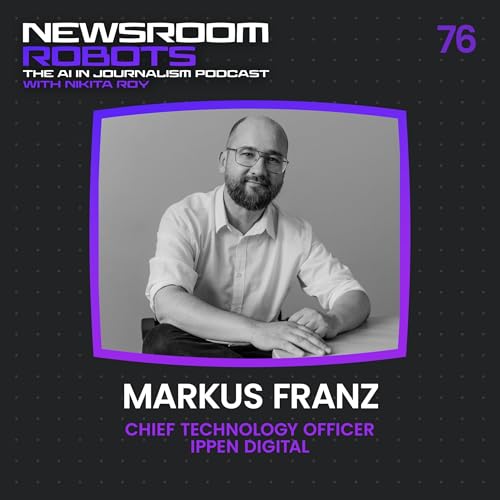This week on Newsroom Robots, host Nikita Roy sits down with Vilas Dhar, President of the Patrick J. McGovern Foundation, one of the world's foremost philanthropies advancing AI for public good. Dhar leads a $1.5 billion endowment that has committed over $500 million to projects spanning climate action, public health, education, and democratic governance. He has served on the UN Secretary-General's High-Level Advisory Body on AI, is the U.S. government's nominated expert to the Global Partnership on AI, and was named a World Economic Forum Young Global Leader in 2022.
Across philanthropy, policy, and technology, Dhar carries one central conviction: technology may accelerate, but the future of journalism and society must remain human-centered. Dhar introduces a three-part framework for ethical AI deployment (responsible data, clear boundaries, and transparency) and explains how to translate abstract principles into concrete newsroom decisions. He unpacks his LISA framework (Listen, Involve, Share, Assess) for audience-centered AI design, and tackles the hardest questions facing newsroom leaders: Should we buy or build AI tools? How do we balance innovation with environmental sustainability? What happens to human creativity when machines can create?
But perhaps most powerfully, Dhar challenges a deeply held belief in journalism: that media organizations can remain ‘just’ media companies in an AI-driven world. There is no way to be a media organization today without also being a technology organization, he argues, and that shift requires not just new tools, but a fundamental reckoning with organizational identity and purpose.
This epiosde covers:
00:31 – Introducing Vilas Dhar and his human-centered AI vision: Why technology should serve dignity, equity, and democracy—not just profit
02:17 – The three-part framework for ethical AI: Responsible data, clear boundaries, and transparency as actionable principles
07:08 – Questions leaders must ask before deploying AI: Who's involved? Who's accountable? Who has editorial control over AI use?
10:16 – The LISA framework: Listen, Involve, Share, Assess to turn AI experimentation into behind-the-scenes reporting that builds public trust
13:30 – Navigating ethical dilemmas around AI-generated content
13:51 – The three phases of newsroom AI adoption
18:54 – Why "we're not a tech company" no longer works
23:12 – Organizational reckoning in an 18-month transformation cycle
25:23 – Why smaller, targeted models and collective action matter more than massive systems
29:14 – Fighting misinformation with AI
34:13 – What journalism is missing compared to other industries
37:01 – The evolving role of human creativity and agency
39:33 – The McGovern Foundation's North Star
44:23 – How Vilas uses AI personally
Sign up for the Newsroom Robots newsletter for episode summaries and insights from host Nikita Roy.
Hosted on Acast. See acast.com/privacy for more information.
 Nov 26 202552 mins
Nov 26 202552 mins 1 hr and 6 mins
1 hr and 6 mins 47 mins
47 mins 41 mins
41 mins 1 hr and 6 mins
1 hr and 6 mins 48 mins
48 mins 52 mins
52 mins 1 hr and 4 mins
1 hr and 4 mins

